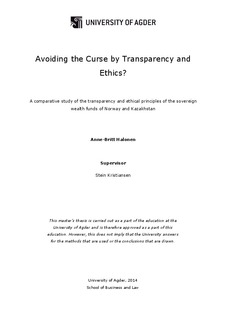| dc.description.abstract | The purpose of this thesis is to explore how transparency and ethics in sovereign wealth funds may contribute in avoiding the resource curse, and compare how the sovereign wealth funds of Norway (the Norwegian Government Pension Fund Global – NGPFG) and Kazakhstan (the National Fund of the Republic of Kazakhstan – NFRK, and Samruk-Kazyna) implement transparency and ethics in their practical operations.
Researchers such as Kolstad and Wiig (2009) and Williams (2011) have connected the resource curse to transparency. Resource funds, or sovereign wealth funds, work as tools in combating certain aspects of the curse, and in this thesis transparency is therefore directly linked up to sovereign wealth funds. Based on different transparency models (International Forum of Sovereign Wealth Funds, 2008; SWF Institute, 2013; Truman, 2010), an analytical framework is developed to assess the level of sovereign wealth fund transparency.
Further, researchers like Hawley and Williams (2000), Kiernan (2009) and Richardson (2011) argue that ethical principles in the investment practices of sovereign wealth funds may improve their performance and sustainability, making them better able to meet the needs of future generations. I therefore suggest and try to explore how ethical principles in sovereign wealth funds work as relevant tools in combating the curse by affecting elements of fund performance.
Interviews have been conducted in Kazakhstan, and public documents have been investigated to collect data on the transparency and ethical conduct of the Norwegian and Kazakhstani funds. The NGPFG clearly stands out as more transparent than the Kazakhstani funds, as it publishes comprehensive, understandable and easily available information. Hence, it is in a better position to keep leaders honest, avoid rent-seeking and corruption and encourage public debate, amongst others, thus likely enhancing profitability and stability. Further, the NGPFG is the only fund among the three that systematically implements ethical principles, based on the belief that it enhances long-term return and sustainability. Samruk-Kazyna does to some extent consider ethical issues via its involvement in CSR. The NGPFG, and to some degree Samruk-Kazyna, are therefore likely better at facilitating growth and sustainability also for future generations. According to the ideas presented in this thesis, and due to its level of transparency and ethical principles, the NGPFG is thus better able at contributing to resource curse avoidance on a longer time perspective than the two Kazakhstani funds. Hence, the Kazakhstani funds should implement measures for improving their ability to defeat the curse. | nb_NO |
